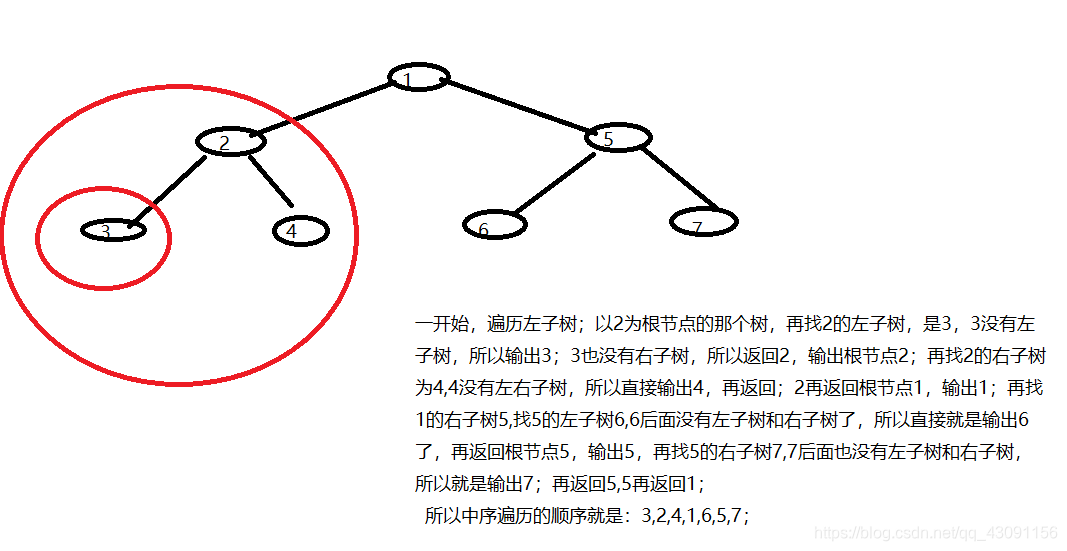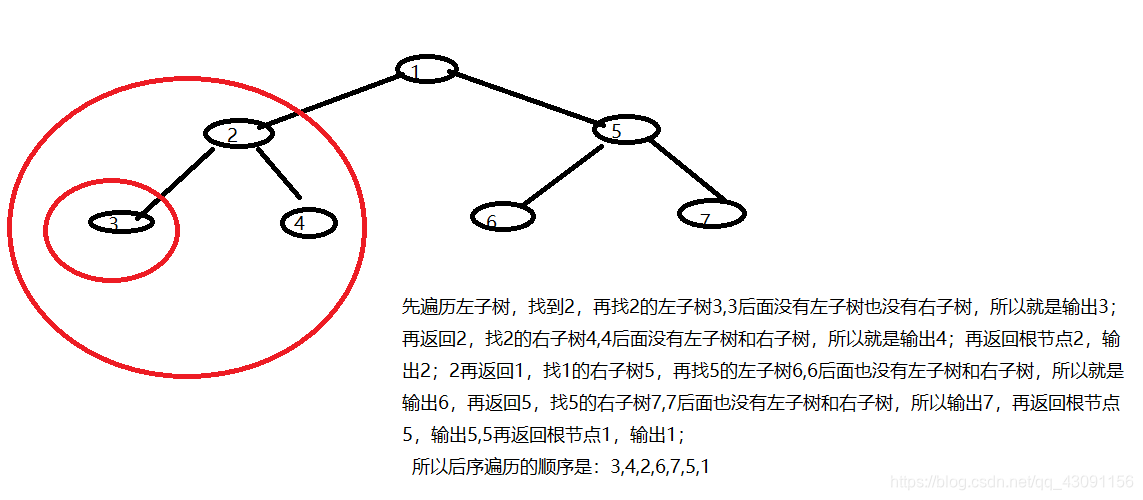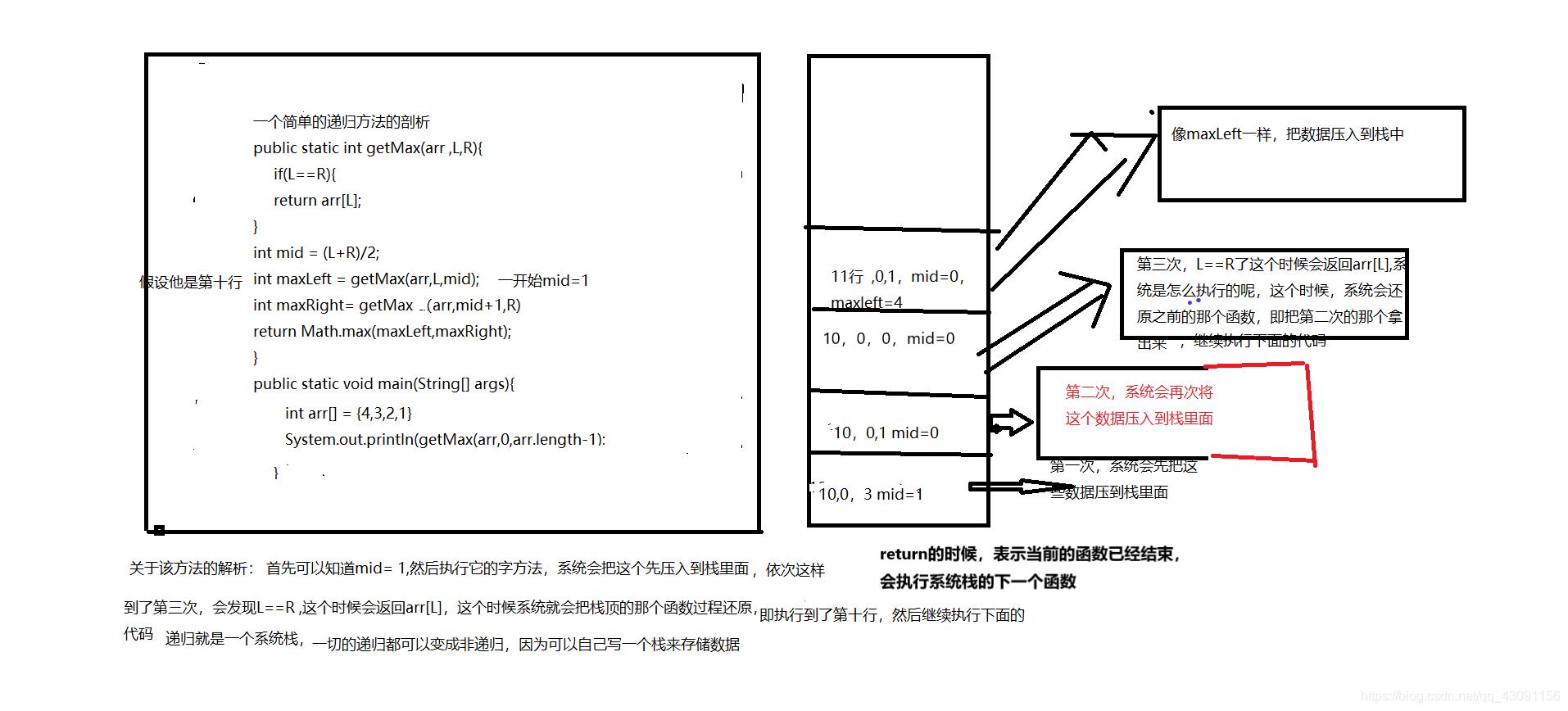二叉树的先序遍历:
1:访问根节点
2:访问左子树
3:访问右子树

二叉树的中序遍历:
1:中序遍历左子树
2:访问根节点
3:中序遍历右子树

二叉树的后序遍历:
1:后序遍历左子树
2:后序遍历右子树
3:访问根节点

使用递归的方式来实现二叉树的几种遍历:
public class Code_01_PreInPosTraversal {
public static class Node {
public int value;
public Node left;
public Node right;
public Node(int data) {
this.value = data;
}
}
public static void preOrderRecur(Node head) { //递归的方式 先序遍历
if (head == null) {
return;
}
System.out.print(head.value + " ");
preOrderRecur(head.left);
preOrderRecur(head.right);
}
public static void inOrderRecur(Node head) { // 递归的方式 中序遍历
if (head == null) {
return;
}
inOrderRecur(head.left);
System.out.print(head.value + " ");
inOrderRecur(head.right);
}
public static void posOrderRecur(Node head) { //递归的方式 后序遍历
if (head == null) {
return;
}
posOrderRecur(head.left);
posOrderRecur(head.right);
System.out.print(head.value + " ");
}
这里的return返回是此函数的结束处,相应的变量的参数也会返回到上一层的参数处,覆盖原来的参数,继续此函数之后未完成的函数动作,如果此函数执行完则跳出此层递归,继续返回上次未完成的函数处(递归调用处)。
理解一下递归的实质:
使用非递归的方法:
注意return:return的时候代表这个子函数已经执行完毕了,使用再执行的是下一个栈元素
import java.util.Stack;
public class Code_01_PreInPosTraversal {
public static class Node {
public int value;
public Node left;
public Node right;
public Node(int data) {
this.value = data;
}
}
public static void preOrderRecur(Node head) { //递归的方式 先序遍历
if (head == null) {
return;
}
System.out.print(head.value + " ");
preOrderRecur(head.left);
preOrderRecur(head.right);
}
public static void inOrderRecur(Node head) { // 递归的方式 中序遍历
if (head == null) {
return;
}
inOrderRecur(head.left);
System.out.print(head.value + " ");
inOrderRecur(head.right);
}
public static void posOrderRecur(Node head) { //递归的方式 后序遍历
if (head == null) {
return;
}
posOrderRecur(head.left);
posOrderRecur(head.right);
System.out.print(head.value + " ");
}
public static void preOrderUnRecur(Node head) { //先序遍历 非递归
System.out.print("pre-order: ");
if (head != null) {
Stack<Node> stack = new Stack<Node>();
stack.add(head);
while (!stack.isEmpty()) {
head = stack.pop();
System.out.print(head.value + " ");
if (head.right != null) { //先序遍历要先把右边的压入栈中
stack.push(head.right);
}
if (head.left != null) {
stack.push(head.left);
}
}
}
System.out.println();
}
public static void inOrderUnRecur(Node head) { //中序遍历 非递归
System.out.print("in-order: ");
if (head != null) {
Stack<Node> stack = new Stack<Node>();
while (!stack.isEmpty() || head != null) { //这个条件是当head在最高的节点时和head的左边为空时这个边界
if (head != null) { //把左边的节点依次压入栈中
stack.push(head);
head = head.left;
} else {
head = stack.pop(); //左边已经为空了,弹出,看右边有没有节点
System.out.print(head.value + " ");
head = head.right;
}
}
}
System.out.println();
}
public static void posOrderUnRecur1(Node head) { //后序遍历 非递归 使用两个栈
System.out.print("pos-order: ");
if (head != null) {
Stack<Node> s1 = new Stack<Node>();
Stack<Node> s2 = new Stack<Node>();//用来存放按后序排序好的二叉树
s1.push(head);
while (!s1.isEmpty()) {
head = s1.pop();
s2.push(head);
if (head.left != null) {
s1.push(head.left); //放到栈S2时刚好左子树的在右子树的上面
}
if (head.right != null) {
s1.push(head.right);
}
}
while (!s2.isEmpty()) {
System.out.print(s2.pop().value + " ");
}
}
System.out.println();
}
public static void posOrderUnRecur2(Node h) { //使用一个栈
System.out.print("pos-order: ");
if (h != null) {
Stack<Node> stack = new Stack<Node>();
stack.push(h);
Node c = null;
while (!stack.isEmpty()) {
c = stack.peek();//取出但不销毁,还是在原来的栈中
if (c.left != null && h != c.left && h != c.right) {
stack.push(c.left);
} else if (c.right != null && h != c.right) { //防止一个节点被压入两次
stack.push(c.right);
} else {
System.out.print(stack.pop().value + " ");
h = c;
}
}
}
System.out.println();
}
自己好好理解非递归,再自己敲一遍。








 本文介绍了二叉树的三种遍历方式:先序、中序和后序遍历,并详细阐述了递归与非递归的实现方法。通过理解递归实质与掌握非递归技巧,有助于深入理解二叉树操作。
本文介绍了二叉树的三种遍历方式:先序、中序和后序遍历,并详细阐述了递归与非递归的实现方法。通过理解递归实质与掌握非递归技巧,有助于深入理解二叉树操作。

















 被折叠的 条评论
为什么被折叠?
被折叠的 条评论
为什么被折叠?








